Trinidad, Cuba
After saying good-bye to our casa hosts in Viñales, we hit the road again and drove to Trinidad where we spent our final three nights in Cuba.
Hostal Alay & Yaimara
In Trinidad, we split into two groups and stayed at casas particulares again. I was in a house called ‘Hostal Alay & Yaimara’ – two of the couples in our photography group had rooms on the ground floor, while four of us singletons were upstairs in individual rooms around a courtyard.
 Carrying our luggage to our casa.
Carrying our luggage to our casa. There were two single beds in my room – I slept in the bed next to the window. I could’ve simply left my windows open to let the breeze in, but with the fresh air came mozzies, and so at night I kept the windows shut and used my fan or air-conditioning unit to keep cool.
Power adapters for Cuba
As long as you have plugs or adapters for BOTH American (Type B, for three-prong and two-prong plugs) and European (Type C, two-prong plugs) and you should be covered. In Havana and Viñales, the power outlets were American Type B; in Trinidad, they were European Type C. Power supply in Cuba is mostly 110 volts, but you’ll also find 220 volt outlets. For more info, check out Power Plugs and Sockets of the World.
I always travel with a power board as there’s never a guarantee there’ll be enough power points – even in a hotel room and even Australia, never mind Cuba! I’ve always got multiple devices to charge e.g. phone, iPad, and, after a big day of shooting, multiple camera batteries (I even bring two camera battery chargers). Bringing a power board is also advantageous because you only need to use one adapter, for the power board to the socket. Everything else will just plug into the power board.
 My room
My roomWe had breakfast in the upstairs courtyard each morning. Like our casa breakfast in Viñales, it was simple and pretty much the same every day. Fresh fruit (banana, pineapple, papaya), fresh fruit juice (usually papaya), coffee, and eggs cooked to your liking. I had fried eggs with perfectly soft yolks all three mornings. Throughout the trip, I hand-washed my undies and shirts myself, hanging them up to dry in my bathroom. I did the same in Trinidad but also paid $5CUC to my casa hosts for a bag of clothes to be washed – a few pairs of shorts and trousers. We were each given keys for our rooms and for the front door of the casa and were free to come and go as we pleased, but I never once managed to unlock the front door with my key – it fitted into the keyhole with no problems, but turned ineffectually. Like in Viñales, I got up early each morning and walked to the town square to use the wifi before breakfast; fortunately, one of our hosts was always around and didn’t mind letting me back into the house.
 Even after a walk to the town square and back, I was usually first to the table for breakfast on the balcony.
Even after a walk to the town square and back, I was usually first to the table for breakfast on the balcony. Breakfast: fried eggs, fruit, fresh juice and coffee.
Breakfast: fried eggs, fruit, fresh juice and coffee. About toilets in Cuba
My toilet and shower in the casa at Trinidad, with a bin next to the toilet for used toilet paper. In addition tipping my hosts, I left my surplus unused toilet rolls in the casa in Trinidad.
The most important aspect of Cuban toilet etiquette is knowing not to flush your used paper down the toilet; it is not a good idea to flush toilet paper as the plumbing will get blocked. Accordingly, next to every toilet is a bin for your used toilet paper. I didn’t want to take any chances and risk blocking my toilet, so I followed the ‘no flushing toilet paper’ rule religiously. This isn’t unique to Cuba, by the way – South American countries have similar issues with plumbing and toilet paper.
The toilets in our hotel in Havana and in the casas particulares in Viñales and Trinidad were the regular sit-down flushing kind. Toilets at roadhouses we stopped at during our bus trips and at restaurants varied in cleanliness and functionality; they were all the sit-down kind, but some had no toilet seat and some didn’t flush at all.
In general, you have to pay to use public toilets in Cuba. At the roadhouses for example, there would be someone sitting outside the toilets that you had to pay 25 cents before you could enter. Sometimes that 25 cents also got you (literally) two squares of toilet paper (other than those two squares from the toilet sentry, don’t expect to find toilet paper in public toilets in Cuba). Sometimes there was soap at the sink, most times there wasn’t any. And as a few of us discovered, don’t expect to get anything back if you don’t happen to have the right change – your generous payment will be accepted with a smile, and that’s it!
A drawing on the wall of the toilet at a restaurant in Havana. The Spanish translates to: “Is that your piece of paper? Put it in the basket!”
The things we take for granted back home like toilet paper and soap are in short supply in Cuba, and so even for paying guests in hotels and casas they’re sparingly supplied. Anticipating potential shortages, I brought a few rolls of toilet paper in my suitcase. Something I noticed right away was that Cuban toilet paper was not as soft as my toilet paper from home.
Each day, along with my camera gear, I’d pack a toilet kit in a zip-lock bag: enough toilet paper and change for a couple of public toilet visits, plus a little bottle of hand sanitiser. We didn’t have to pay to use the toilets at restaurants since we were dining there, but we definitely had to pay at public toilets. My daily toilet kit ensured I was prepared for anything. The hand sanitiser doesn’t require water – so I could ensure I had clean hands and practised reasonably good hygiene even without access to soap and water.
The sign on the back of the toilet door at Restaurante Finca Agroecologica El Paraiso in Viñales
It was such a pleasure and relief to be able to flush toilet paper again once I was back in Miami. I must say however, that American toilets are much shallower and the flush pressure seems much weaker than Australian toilets – so I wasn’t completely back in my comfort zone until I was in Sydney. When using American toilets, I always feel nervous that my ‘deposit’ will remain in the bowl after flushing.
TMI? OK- I promise, that’s all the toilet talk for this post.
Restaurante Museo 1514
On our first evening in Trinidad, we enjoyed dinner, live music and dancing (well, I didn’t dance, but the others did) at Restaurante Museo 1514.
 The restaurant resembled bric-a-brac shop; on every table was (I thought) a ridiculous amount of glassware and crockery. All around was clutter: statues and ornaments, wine and spirit bottles, lamps and candelabra, more glassware; on the walls, ornately framed pictures and clocks.
The restaurant resembled bric-a-brac shop; on every table was (I thought) a ridiculous amount of glassware and crockery. All around was clutter: statues and ornaments, wine and spirit bottles, lamps and candelabra, more glassware; on the walls, ornately framed pictures and clocks.  The soup course was delivered via silver service.
The soup course was delivered via silver service.  Our Cuban guide informed the staff of my crustacean allergy, and so I was served chicken soup while everyone else in the group received seafood soup. My soup was full of chicken and absolutely delicious.
Our Cuban guide informed the staff of my crustacean allergy, and so I was served chicken soup while everyone else in the group received seafood soup. My soup was full of chicken and absolutely delicious. The band was terrific. I was sitting right next to the guitarist. When they finished their set, a few of us bought their CD.
The band was terrific. I was sitting right next to the guitarist. When they finished their set, a few of us bought their CD.  The trumpet player was also the lead singer (obviously, he sang when not blowing the trumpet).
The trumpet player was also the lead singer (obviously, he sang when not blowing the trumpet).  For main course I had roast chicken, yuca and rice. In the little glass was a fresh tomato and garlic sauce, garnished with lime.
For main course I had roast chicken, yuca and rice. In the little glass was a fresh tomato and garlic sauce, garnished with lime.  Flan and fruit for dessert. I didn’t care for the antique shop decor, but I really enjoyed the food and music.
Flan and fruit for dessert. I didn’t care for the antique shop decor, but I really enjoyed the food and music.Cowboys
We had a photo session at an unused train station with some Cuban cowboys. I found it difficult to take pictures of the cowboys as there were simply too many of us all gathered around our cowboy models, and my fellow photographers kept photobombing my shots. When you’re in a group of photographers, it’s unrealistic to expect that no one will unintentionally wander into your frame and spoil your shot, but on this trip, photobombing was quite a problem and made a few people very cranky. In those situations, I would just walk away and do my own thing as best I could. These sorts of tensions have put me off booking another photography group tour… at least for a while.

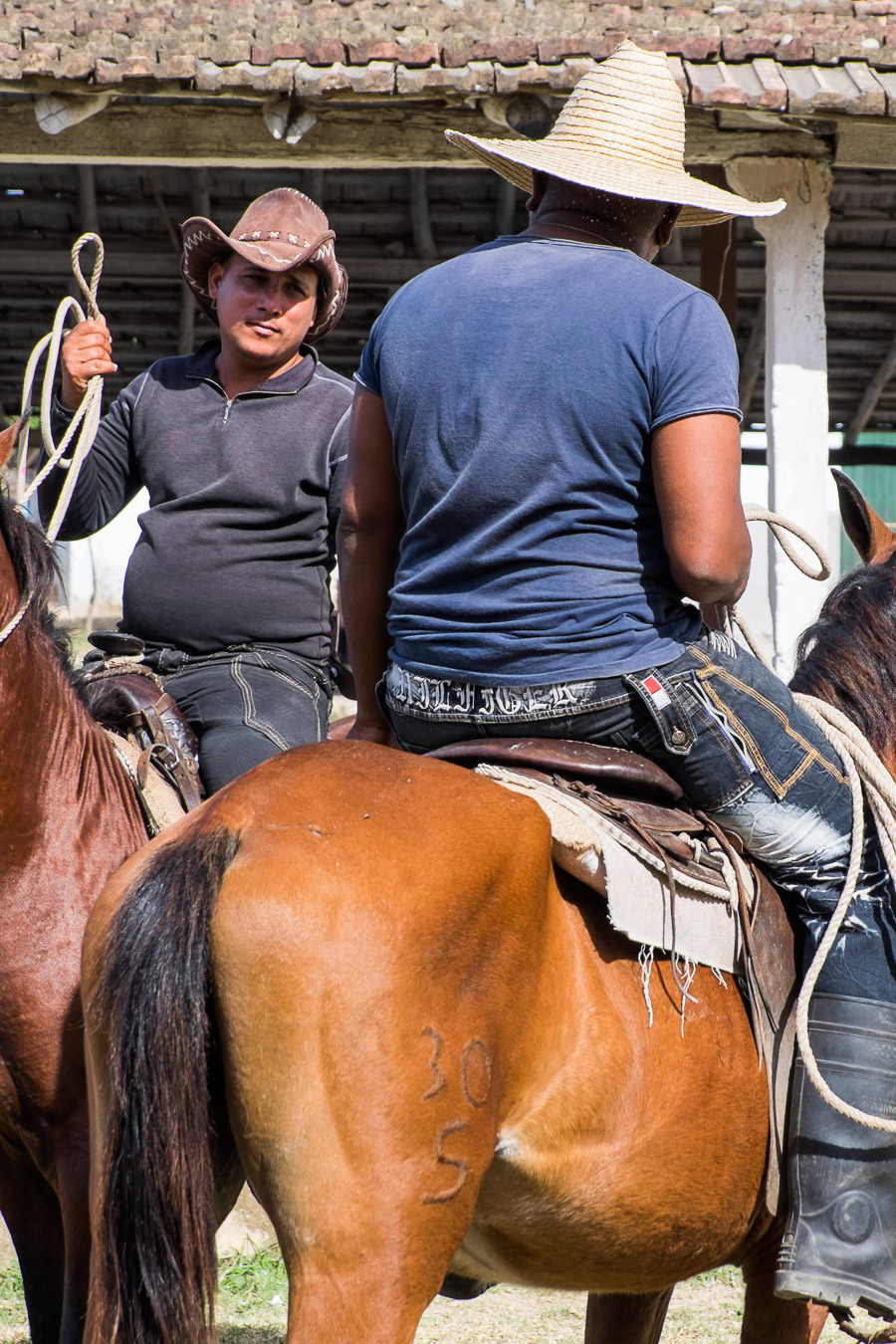



 Our lunch venue was a ranch called Hacienda Guachinango.
Our lunch venue was a ranch called Hacienda Guachinango. We sat at one of the long tables on the veranda.
We sat at one of the long tables on the veranda. A pig was roasting on the spit when we arrived. The aromas of woodfire smoke and roasting pork were fantastic. Most of our group ordered the roast pork for lunch; a few people ordered roast chicken. No way could I contemplate chicken after seeing and smelling the roasting pig.
A pig was roasting on the spit when we arrived. The aromas of woodfire smoke and roasting pork were fantastic. Most of our group ordered the roast pork for lunch; a few people ordered roast chicken. No way could I contemplate chicken after seeing and smelling the roasting pig.  I mentioned previously most restaurant meals in Cuba begin with a simple salad course – this one consisted of shredded cabbage, tomato and avocado.
I mentioned previously most restaurant meals in Cuba begin with a simple salad course – this one consisted of shredded cabbage, tomato and avocado.  The roast pork was taking a terribly long time and it looked as though we’d have to switch our orders to chicken, as we didn’t want to risk being late to our next activity. Miraculously, before the chicken was served, the pig on the spit was pronounced ready for eating. I wouldn’t have made a fuss if we’d had to switch to the chicken, but I would’ve been secretly disappointed to have come so close to the roast pig on a spit and not taste any!
The roast pork was taking a terribly long time and it looked as though we’d have to switch our orders to chicken, as we didn’t want to risk being late to our next activity. Miraculously, before the chicken was served, the pig on the spit was pronounced ready for eating. I wouldn’t have made a fuss if we’d had to switch to the chicken, but I would’ve been secretly disappointed to have come so close to the roast pig on a spit and not taste any!  Carving the roast pork on a bed of banana leaves. The crackling was first to be carefully carved and shared around.
Carving the roast pork on a bed of banana leaves. The crackling was first to be carefully carved and shared around.  Our plates were filled rapidly with pork, yuca, rice and beans and a ladle of garlicky pork jus over the meat.
Our plates were filled rapidly with pork, yuca, rice and beans and a ladle of garlicky pork jus over the meat. Roast pork, rice and beans, and yuca. The pork tasted as amazing as I’d hoped.
Roast pork, rice and beans, and yuca. The pork tasted as amazing as I’d hoped.  The resident dog hovered, hoping for a treat.
The resident dog hovered, hoping for a treat.  This cowboy was a favourite among the ladies in our group. He was happy to pose for pictures but was quite bashful.
This cowboy was a favourite among the ladies in our group. He was happy to pose for pictures but was quite bashful.  There is accommodation at the ranch – I snuck a peek into one of the rooms.
There is accommodation at the ranch – I snuck a peek into one of the rooms. Taberna La Botija
On another day, we had a fun pizza lunch at Taberna La Botija. It’s a very popular restaurant; there’s usually a queue waiting to get in, and there was a line waiting by the time we finished our meal.
 Tomato pizza
Tomato pizza Most people in our group were very well-mannered and ate the pizza with fork and knife (me, not quite so well-mannered).
Most people in our group were very well-mannered and ate the pizza with fork and knife (me, not quite so well-mannered).  The beef mince (with sweet caramelised onions) pizza was my favourite. There was a prawn pizza and lobster pizza as well; since I couldn’t eat either of those, I had extra slices of the beef mince pizza and tomato pizza. No one was unhappy about eating my share of the prawn and lobster pizzas.
The beef mince (with sweet caramelised onions) pizza was my favourite. There was a prawn pizza and lobster pizza as well; since I couldn’t eat either of those, I had extra slices of the beef mince pizza and tomato pizza. No one was unhappy about eating my share of the prawn and lobster pizzas. Trinidad scenes
There were plenty of interesting scenes to photograph in Trinidad. I went to bed each night with sore feet and tired legs from walking around the cobblestone streets. The roads were uneven and in poor repair, and I had to concentrate and tread carefully to avoid twisting an ankle. In the evening walking back from dinner, I used my headlamp as a torch. The older members of our group found the winding cobblestone streets physically challenging, and skipped a couple of activities that involved a lot of walking. I was quite surprised to observe many elderly tourists in Trinidad; it’s definitely not a place I’d recommend to anyone with mobility and/or fitness issues.

 Trinidad is a UNESCO World Heritage sites and a lot of work is being done to restore and preserve the colonial buildings. These unique doors are a feature of many of the buildings in Trinidad – the larger, taller ‘outer’ door was used to give horse and cart access into a property, while people used the smaller door that was built into that larger door.
Trinidad is a UNESCO World Heritage sites and a lot of work is being done to restore and preserve the colonial buildings. These unique doors are a feature of many of the buildings in Trinidad – the larger, taller ‘outer’ door was used to give horse and cart access into a property, while people used the smaller door that was built into that larger door. 
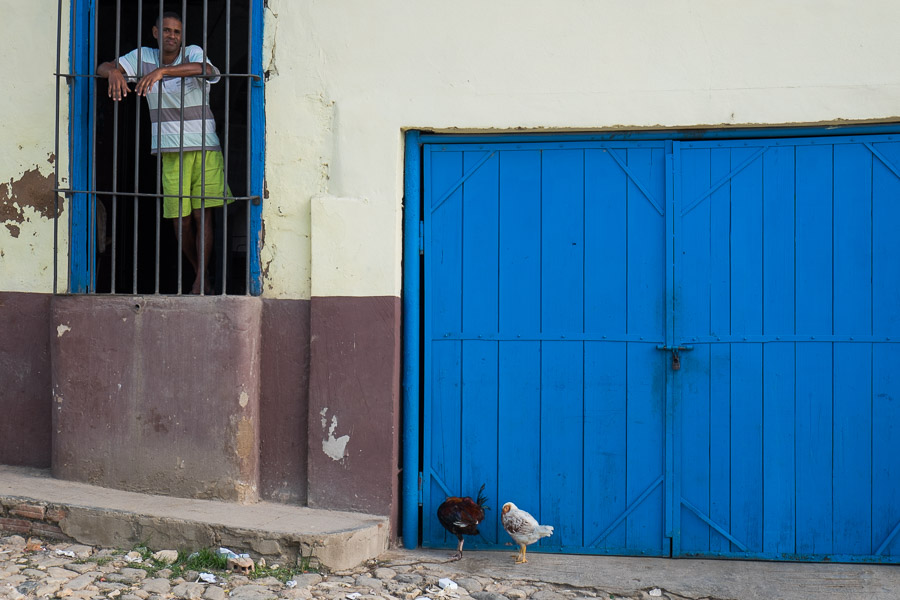

 These are tourists who had just stepped off their tour bus. There were LOTS of tour buses in Trinidad. I presume it will only grow more popular as a tourist destination. Our Cuban guide told me she had seen an exponential increase in visitors in just the past year.
These are tourists who had just stepped off their tour bus. There were LOTS of tour buses in Trinidad. I presume it will only grow more popular as a tourist destination. Our Cuban guide told me she had seen an exponential increase in visitors in just the past year.  Every day, market stalls were set up, selling T-shirts and all kinds of souvenirs.
Every day, market stalls were set up, selling T-shirts and all kinds of souvenirs.  When I sat on these steps to use wifi on my first morning in Trinidad, this pack of stray dogs gathered around me (I was sitting in the space next to the white dog – I took this photo before I left). They were not aggressive towards me but I found it quite unnerving to be so close to them. I was careful not to make any sudden movements as I didn’t know what they might do if startled or (mistakenly) threatened. Sure, I had full medical insurance, but I didn’t fancy being bitten. One of the dogs even rested its chin on my foot as I sat there – as I said, unnerving!
When I sat on these steps to use wifi on my first morning in Trinidad, this pack of stray dogs gathered around me (I was sitting in the space next to the white dog – I took this photo before I left). They were not aggressive towards me but I found it quite unnerving to be so close to them. I was careful not to make any sudden movements as I didn’t know what they might do if startled or (mistakenly) threatened. Sure, I had full medical insurance, but I didn’t fancy being bitten. One of the dogs even rested its chin on my foot as I sat there – as I said, unnerving!  Here’s a picture of the same steps from another angle, taken at night when the dogs are replaced with tourists who come to the town square for wifi and mojitos. There were A LOT of tourists in Trinidad.
Here’s a picture of the same steps from another angle, taken at night when the dogs are replaced with tourists who come to the town square for wifi and mojitos. There were A LOT of tourists in Trinidad.  I came across quite a few dogs in Trinidad. Most weren’t stray or scary. Small dogs were very popular as pets… well, they eat less than big dogs!
I came across quite a few dogs in Trinidad. Most weren’t stray or scary. Small dogs were very popular as pets… well, they eat less than big dogs! This cutie’s name is Lulu.
This cutie’s name is Lulu.  This gentleman was very proud of his chihuahua.
This gentleman was very proud of his chihuahua. 
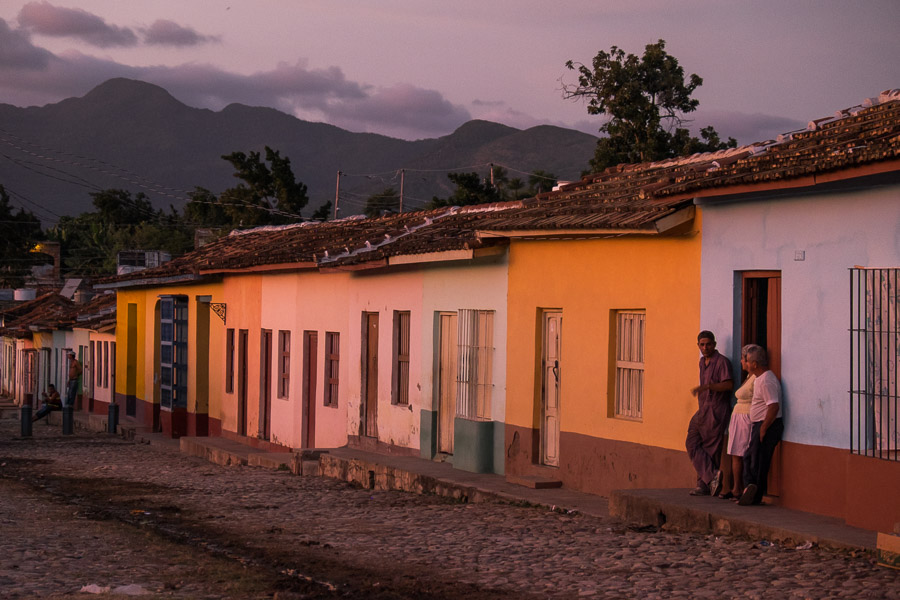 >
>
 Many of the homes we passed on our daily walking excursions were casas particulares.
Many of the homes we passed on our daily walking excursions were casas particulares. 
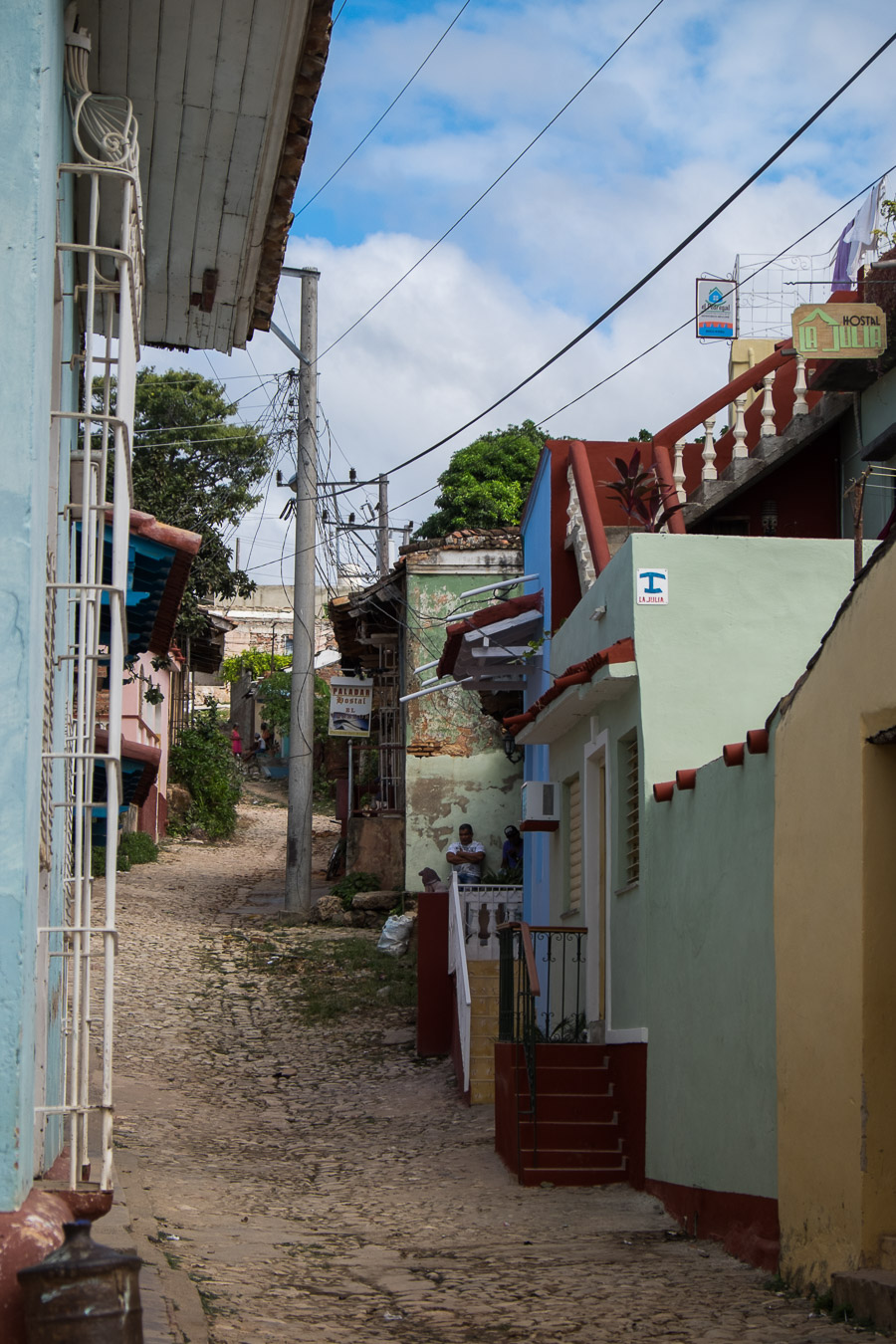
 If you like art, there’s plenty to enjoy in Cuba.
If you like art, there’s plenty to enjoy in Cuba. 
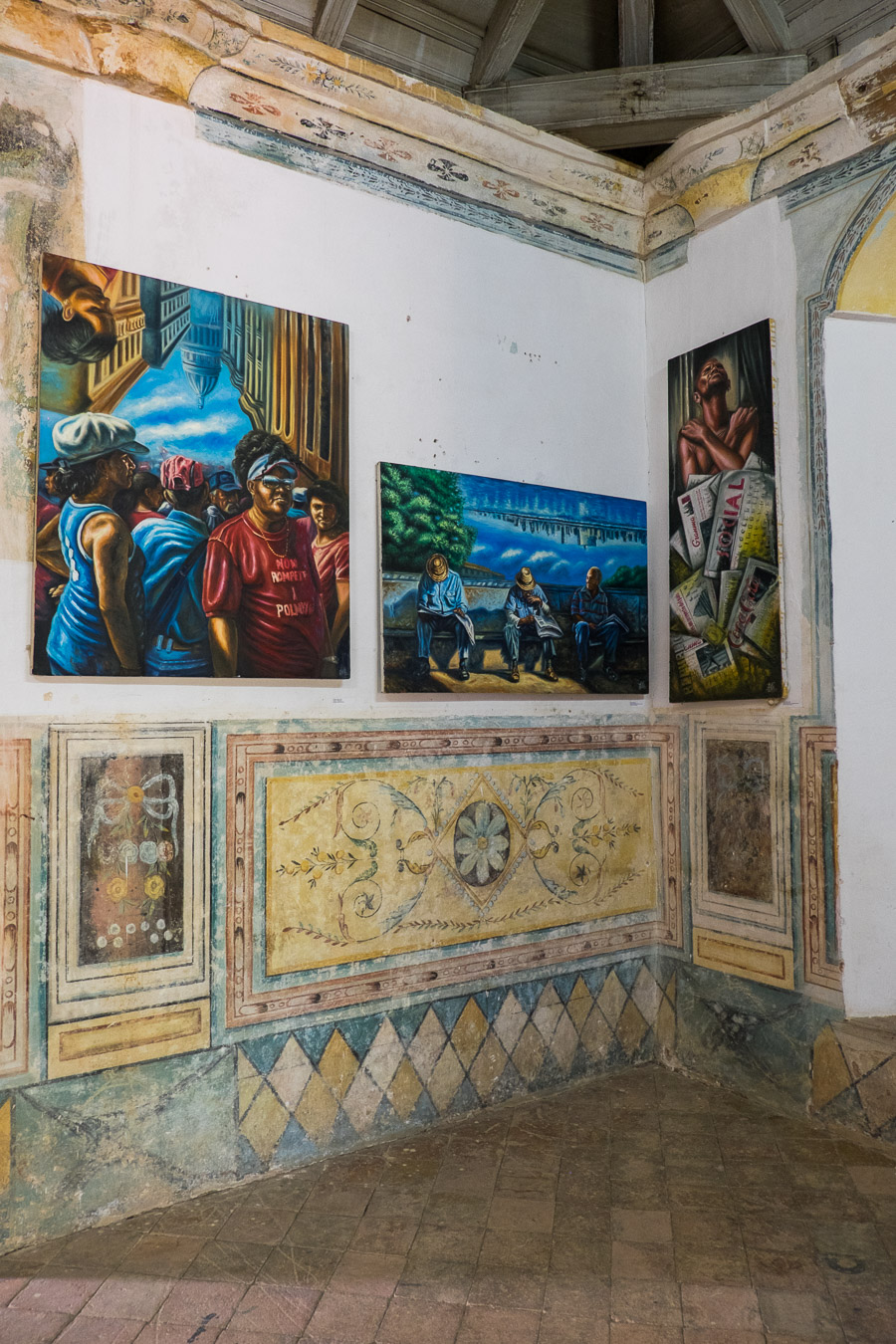

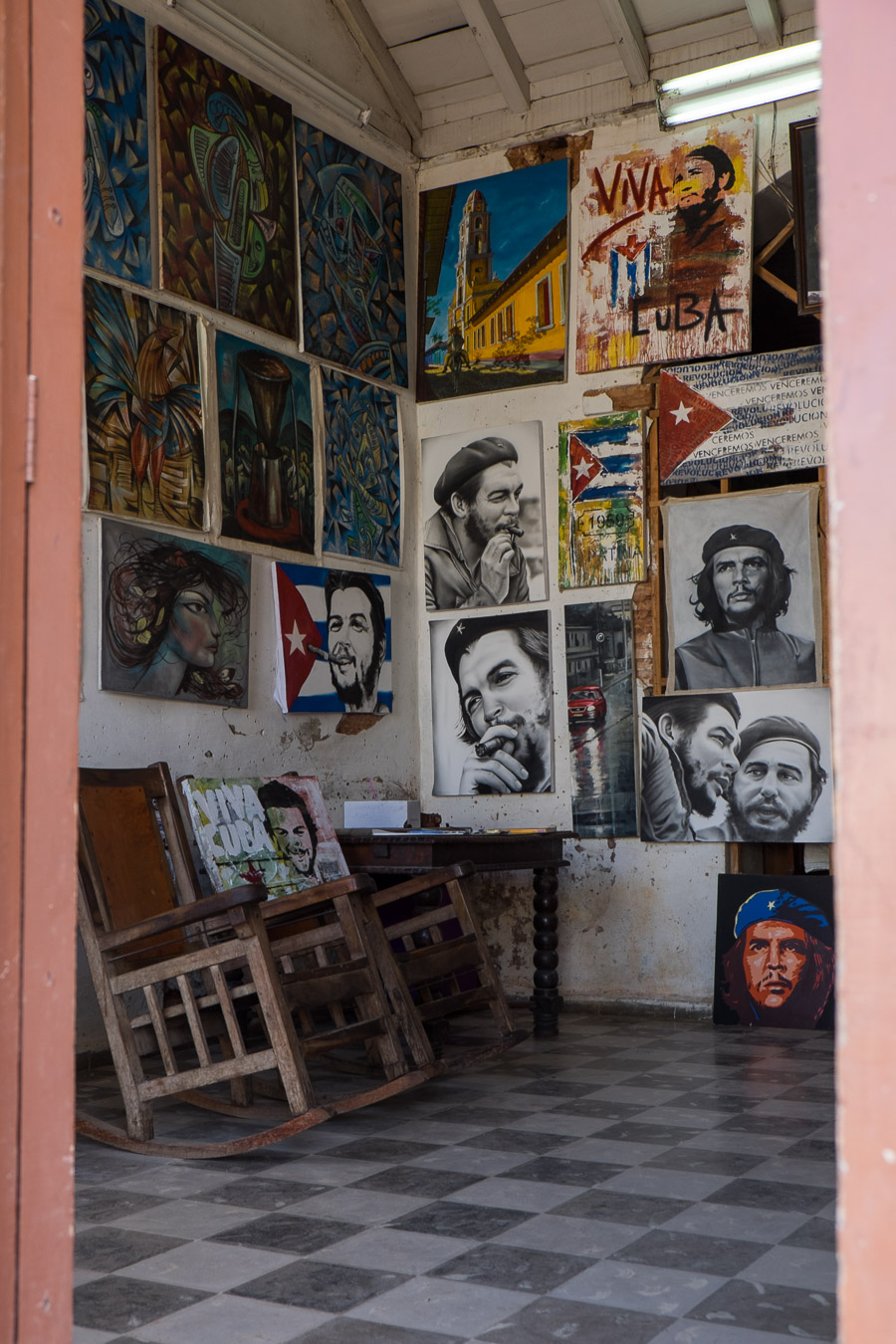
 This is Iznaga tower. The white sheets you see are market stalls selling fabric – tablecloths, aprons, tea towels (dish cloths), sheets. I bought Jac a white table runner embroidered with colourful fruit and vegetables.
This is Iznaga tower. The white sheets you see are market stalls selling fabric – tablecloths, aprons, tea towels (dish cloths), sheets. I bought Jac a white table runner embroidered with colourful fruit and vegetables. You can pay a fee to climb the tower. We didn’t have time, so I had to be content with just taking photographs from the ground.
You can pay a fee to climb the tower. We didn’t have time, so I had to be content with just taking photographs from the ground. Villa Lagarto
Our final meal in Cuba was at a restaurant by Cienfuegos bay called Villa Lagarto, on our drive to Santa Clara Airport where we caught our flight back to Miami.
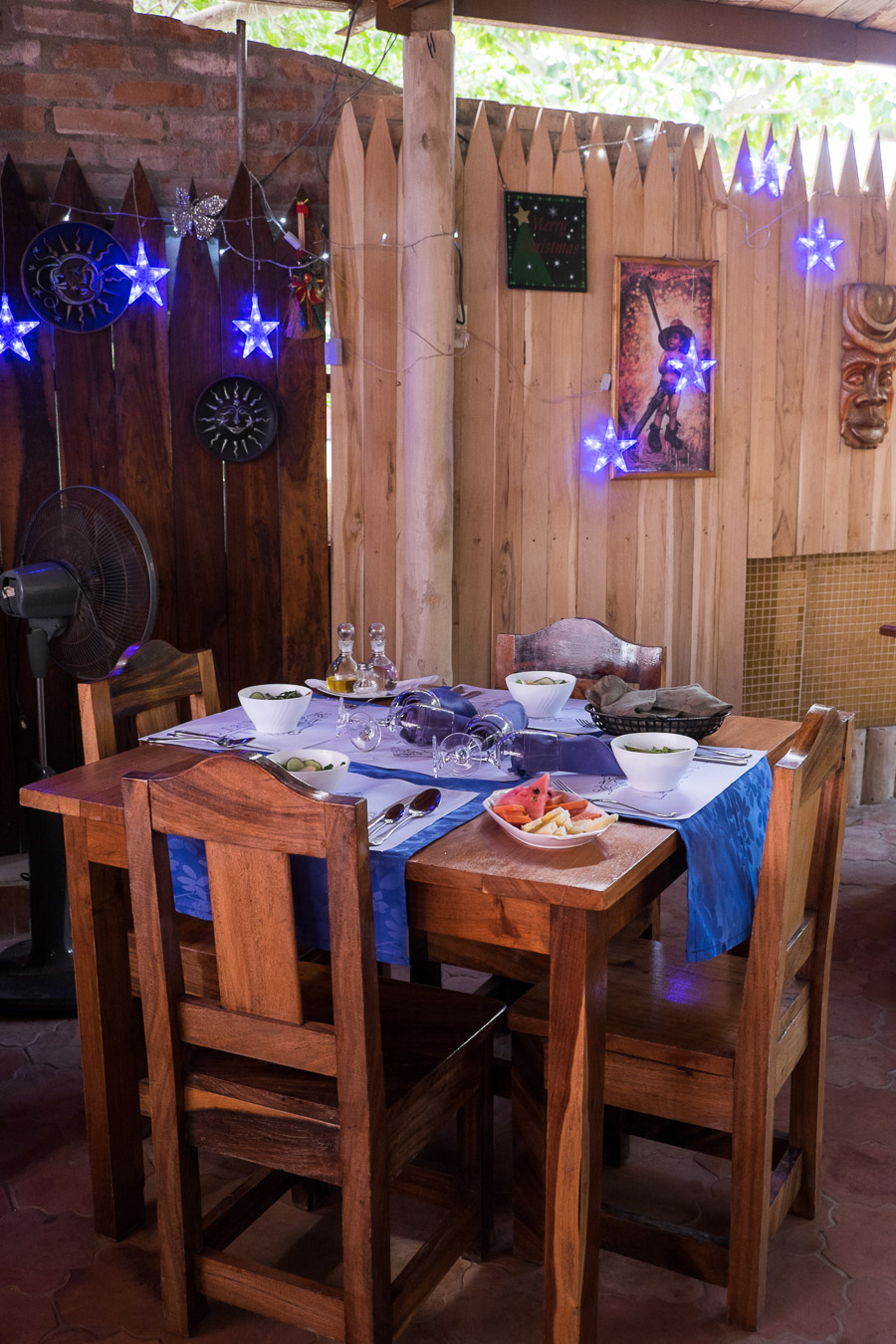 Our tables were set with fresh fruit and salad. Waiters came round to take drink and main course orders.
Our tables were set with fresh fruit and salad. Waiters came round to take drink and main course orders.  After salad and fruit, we had vegetable soup.
After salad and fruit, we had vegetable soup.  For main course, I ordered the roast lamb. It was served on the bone, a hunk of meat so tender I only needed a fork. Also on my plate were yuca, pumpkin and rice.
For main course, I ordered the roast lamb. It was served on the bone, a hunk of meat so tender I only needed a fork. Also on my plate were yuca, pumpkin and rice. 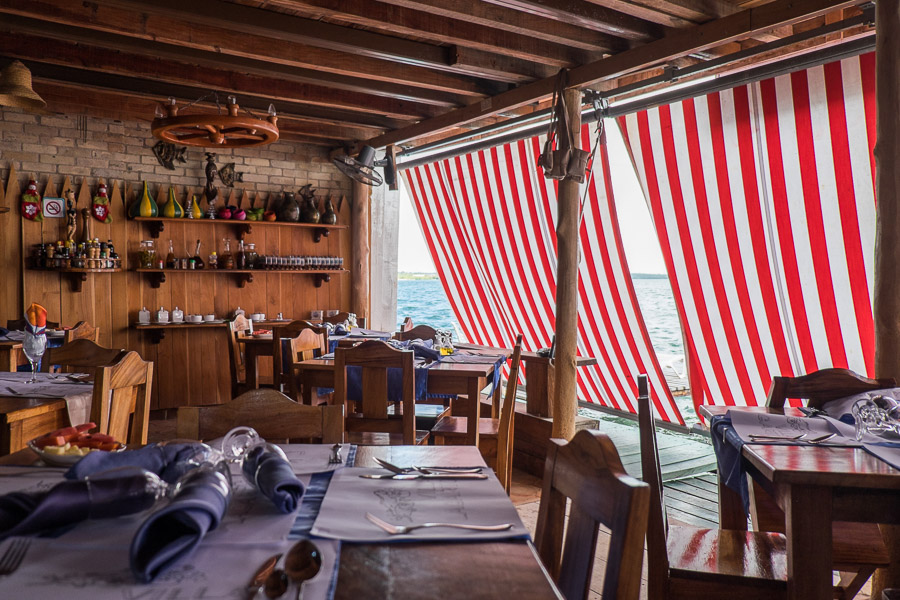 The dining room had a view of the bay, but the shade cloth was down to help block out strong wind.
The dining room had a view of the bay, but the shade cloth was down to help block out strong wind.  Dessert was flan (like creme caramel). We were served flan as dessert for so many of our meals during the trip it became a running joke. I think a few of my fellow photographers will be happy if they never see another flan for YEARS, let alone eat it. This final flan was garnished with sprinkles (what we call ‘hundreds and thousands’ in Australia). Personally, I didn’t mind eating all that flan throughout the trip, just like I really didn’t mind eating rice and beans at just about every lunch and dinner.
Dessert was flan (like creme caramel). We were served flan as dessert for so many of our meals during the trip it became a running joke. I think a few of my fellow photographers will be happy if they never see another flan for YEARS, let alone eat it. This final flan was garnished with sprinkles (what we call ‘hundreds and thousands’ in Australia). Personally, I didn’t mind eating all that flan throughout the trip, just like I really didn’t mind eating rice and beans at just about every lunch and dinner.  Road workers in a street in Trinidad.
Road workers in a street in Trinidad.My Cuba series
I went to Cuba in November 2016, on a photography group tour. This is the final post of the series. Hope you found it interesting.

